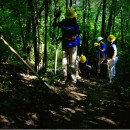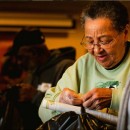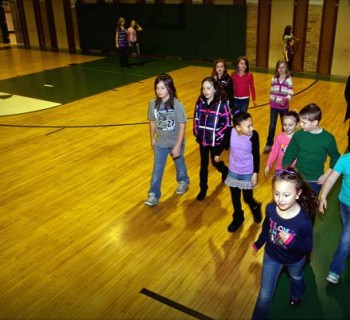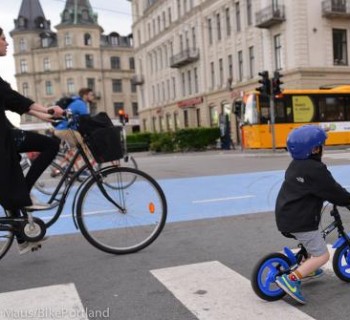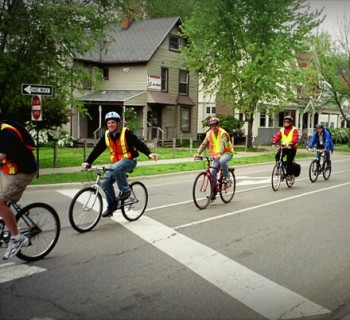Imagine an empty parking lot, maybe at an elementary school or neighborhood park, transformed into a bicycle training program for young people with disabilities – lots of energetic and friendly trainers, nervous students, and even more nervous parents. That will be the case this summer as PEAC, Programs to Educate All Cyclists, begins its summer cycling programs in Taylor, Saline, Ann Arbor, Dexter, and Farmington Hills.
This year, around 250 would-be cyclists, most of them youth with disabilities, will be meeting once or twice a week in these summer programs around southeast Michigan, spending seven weeks working to develop their cycling skills – skills that give them increased independence and confidence and keep them safe while riding.
Liz Horvat, community liaison for PEAC says that summer program students and their parents are most surprised that they don't use training wheels or other adaptive equipment. “Our philosophy is to use the least adaptive equipment and make adaptations from there,” says Horvat.
The students have access to mountain bikes, tandems and tricycles, or they can bring their own bike from home. Bikes are tweaked to make them work for each student. If a child has a hard time keeping their feet on the pedals on a tandem, for instance, PEAC staff and volunteers might add foot cages.
Surprisingly, many youth who enter the program cautious to leave behind their tricycles or training wheels end up on two wheelers, which gives them the most flexibility and freedom when riding.
It’s a combination of providing riders with disabilities that freedom and vital safety skills that makes PEAC such an effective organization. In fact, safety was what first spurred PEAC founder John Waterman, who was working as a special education teacher in Battle Creek, to start this work after one of his students was hit by a car while bicycling in 1984.
The community was outraged and thought that students with disabilities should not be riding bikes, but Waterman thought that what youth really needed was proper training to ride bikes safely. He began working with a small group of students after school on community bike safety skills. In 2004, PEAC became an independent nonprofit.
Along with the summer program, PEAC has other training and safety programs for youth and adult cyclists with disabilities, including 2x2, which pairs sighted tandem captains with blind or visually impaired stokers, and the Active Transportation Initiative, which focuses on fostering independence for people with disabilities through cycling safety education and fixed route training.
“Some of our students will not be able to get their driver's license due to some of the challenges they are facing,” says Horvat. She says that while the state works with students with disabilities until age 26 to teach employment and life skills, they do not provide the skills to help them independently travel to their job sites.
“We are hoping that the bicycle becomes a viable means of transportation for our students,” says Horvat. “The bicycle grants our students access to the communities in which they live and provides for them flexibility and freedom.”
The summer program takes place in parking lots in neighborhoods for this very reason. Students on two-wheelers have ample room to practice steering and stopping in the lots, yet more advanced riders and tandem riders can ride in the neighborhoods for real-world experiences.
Horvat says that PEAC summer program students are working on different cycling goals, like balancing and riding a two-wheel bike, or gaining confidence and endurance on a tandem bike, or perfecting steering and pedaling the tricycle. But all students will learn riding safely and proper signaling (hand signals, stopping at stop signs, and "passing on your left").
Horvat recalls the progress she made with two students with different challenges and assets last summer.
Eden, age 8, diagnosed with cerebral palsy, used an electric wheelchair as her main mode of transportation. On the day of Eden’s initial evaluation, her mom brought her adaptive tricycle, with back support, a waist belt and foot plates, to class as the bike Eden would use in training and at home. After seeing that Eden was skilled at the nuances of her own tricycle while steering around the parking lot track, Horvat decided that Eden would be able to ride on the back of a tandem.
Eden was surprised and excited to ride another bike, but her mom was a little cautious. “After a few laps around the parking lot, it was clear that Eden had found a new love in the tandem bicycle and instead of just learning about community skills from her tricycle, Eden was able to experience the surrounding community on the back of a tandem bike,” says Horvat.
Brian, age 9, worked last summer on two-wheeled skills, but couldn't put all of the steps together. This summer, he came to PEAC again, but wouldn't even look at the two-wheeled bicycle; instead he found a little blue tricycle and pedaled it around the parking lot for 20 minutes. Slowly, PEAC trainers weaned Brian off of the tricycle and onto the tandem and then onto a two-wheeled bicycle without pedals.
Eventually, Brian started to enjoy the freedom and the speed of a two-wheeled bike and became more and more determined to master it. With only two days remaining in the summer program, Brian picked up the two-wheeled bike that he had been walking, scooting and gliding all summer, pushed off and started pedaling. Now that’s freedom – and pure joy!
To volunteer with any PEAC program, contact Laura Padalino at laura@bikeprogram.org.



